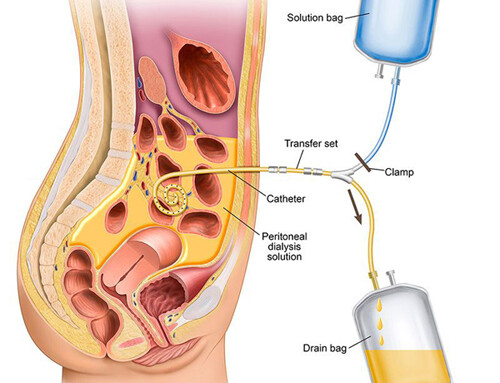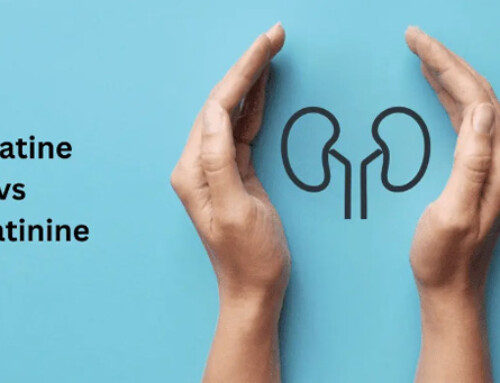Table of Contents
Nutrition is an important part of managing chronic dialysis patients so much so that each unit has a registered dietician.
Things that I focus on when rounding on a dialysis patient include:
- Albumin – Malnutrition and protein energy wasting
- Potassium
- Bicarbonate – Acid Base status
- Vitamins – B complex/ C
- Diabetes
Albumin – Protein Energy Wasting and Malnutrition
This is very common in ESRD patients who may have
- Decreased intake due to anorexia from renal failure and comorbidities
- Catabolic nature of dialysis (@ 10-12 grams of amino acids are lost with each dialysis session).
Adequate protein intake is important for dialysis patients. This is most often assessed with serum albumin. A low serum albumin is associated with worse outcomes, it is a marker for mortality. The target albumin is > 4.
- Patients should be encouraged to have high protein foods. The recommended amount of dietary protein is > 1.2 grams/ kg/ day. A significant number of dialysis patients do not achieve this because of anorexia and comorbidities. Some patients may have restricted protein when they had predialysis CKD. A dietician in a dialysis unit who was successful in achieving high rates of target albumin shared with me her approach. She would ask the patient what they like to eat, then encourage the high protein foods that the patient likes.
- Oral supplements. Recommended if albumin < 3.8. These can be given in the center during the dialysis treatment and/or prescribed at home. They include:
- Concentrated liquid protein – ie Liquacel
- High protein liquid supplements – ie Nepro, Novasource renal
- Protein bars – ie Zone
- IntraDialytic Parenteral Nutrition (IDPN). Recommended for albumin < 3.0
Other ways to assess nutritional status in dialysis patients
- BMI: A BMI < 23 is a marker for protein energy wasting
- Protein Nitrogen Appearance (PNA): This is the rate of BUN increase between dialysis sessions. It should be > 1.2 g/kg/day. This is not something I typically look at, but now I will – stay tuned for an update.
- Low plasma Cholesterol or Creatinine (for ESRD): These may be markers of poor nutritional status.
Megestrol acetate (Megace) can be used as an appetite stimulant: Dose is. 625 mg ( 5 ml of liquid formulation 125 mg/ml). I have used this occasionally, but not routinely. When studied there was a high rate of side effects without clinical benefit.
Potassium
This is an issue that most are familiar with as hyperkalemia can be an important cause of mortality in patients with ESRD. It should be remembered that because of chronic hyperkalemia ESRD have cellular adaptations that allow them to tolerate a higher potassium. Despite this we should target a pre-dialysis potassium < 5.5. We often attribute hyperkalemia to diet, but there are other causes including:
- Fasting state. When fasting there is decreased insulin production. With less insulin less potassium enters cells resulting in hyperkalemia.
- Inadequate dialysis. Missed or shortened treatments are obvious causes. But also consider the possibility of dialysis access recirculation. Essentially this means that the same blood is being dialyzed over and over again, usually because of a venous or outflow stenosis.
Treatment
- Diet – Recommended restriction < 1500 mg day. Important sources include (Oranges, bananas, tomatoes, potatoes)
- Standard dialysate potassium concentrations are 2K and 3K. A 1 K dialysate is also available, but is discouraged as the high potassium shifts associated with this may result in arrhythmias and increased mortality. A better approach is to increase dialysis time with a 2K bath. It is often said that the dialysate potassium plus patients potassium should = 7. In my opinion if the patient’s potassium is < 4 they should be on a 3 K, if > 5 on a 2K, if 4-5 keep them on whatever bath they are on.
- Medical Treatment. If the potassium is > 6 additional treatment is indicated. Ideally this would be increased dialysis time with a 2K dialysate. If this is inadequate or not possible oral potassium binding agents are available. These include
- Kayexalate (Sodium polystyrene sulfonate). This was the traditional medication. May be associated with intestinal ischemia/necrosis. Replaced by newer formulations.
- Veltassa (patiromer) – requires refrigeration
- 4 grams 3 times a week or daily
- Lokelma (sodium zirconium cyclosilicate)
- Acute – 10 grams 3 times a day for 48 hours
- Chronic – 5-10 mg 3 times a week – daily
Lokelma has become the most common medication used for this purpose
Tip: As the majority of body potassium is intracellular, patients are expected to be transiently hypokalemic during and immediately post dialysis. This is an important consideration in patients who may be prone to cardiac arrhythmias (ie on digoxin or with cardiomyopathy). In these cases it may be preferable to use a 3K as opposed to a 2K dialysate and tolerate mild predialysis hyperkalemia. Wait @ 4 hours post dialysis before reassessing potassium and making nonemergent treatment decisions.
Bicarbonate – Metabolic Acidosis/Alkalosis
This may not seem like a nutrition issue, but it needs to be put somewhere. In addition there may be some implications for nutrition.
Metabolic acidosis is associated with muscle wasting as well as metabolic bone disease
Metabolic alkalosis may be a marker for poor nutrition status. Protein tends to be metabolized to acid so a higher protein intake results in more acid production. A metabolic alkalosis may indicate that this is not happening.
The dialysate HCO3 bath can be adjusted. I typically think the range should be 30-38, although it is possible to prescribe higher and lower baths. Remember there are 2 components of the dialysate bath:
Acid: which contains potassium and calcium
Base: which contains bicarbonate
The acid bath provides 4-8 base equivalents that are converted to bicarbonate in vivo.
I generally target a pre-dialysis HCO3 22-28. Higher than 28 may be associated with increased mortality. If it is, look for exogenous alkali (ie na hco3, calcium carbonate) or risk factors for chronic respiratory acidosis (ie obesity hypoventilation, COPD). If not present, decrease the bicarbonate bath.
Vitamins
Dialysis removes water soluble vitamins. So a B complex/C vitamin should be prescribed. There are numerous dialysis formulations. Some examples:
- Dialyvite
- Renocap
- Nephrocap
Vitamin D deficiency is common in ESRD patients as well. It will be addressed in the article on Mineral Bone Disease.
For the water soluble vitamins deficiencies of the following are common in dialysis patients.
- Thiamine (B1)
- Pyridoxine (B6)
- Cobalamin (B12)
- Ascorbic acid (C)
Although you may not see Wernicke encephalopathy, beri beri, or scurvy, some more subtle symptoms of vitamin deficiencies include:
- Unexplained encephalopathy: Vitamin B1 (thiamine)
- High output heart failure: Vitamin B1 (thiamine)
- Neuropathy: Vitamin B6 (pyridoxine), Vitamin B12 (cobalamin)
- Atherosclerotic disease (homocysteinemia): Vitamin B6 (pyridoxine), Vitamin B12 (cobalamin)
- Anemia (functional iron deficiency): Vitamin C (ascorbic acid)
These are common in ESRD and often attributed to uremia or comorbidities. We may be missing symptomatic vitamin deficiencies. (A nephrology board review question was about thiamine deficiency as a cause of high output heart failure in a hemodialysis patient).
Prescribing a renal dialysis multivitamin preparation is easy to do, it is also easy not to do (overlook) as it may not seem important.
Diabetes
Although the role of the nephrology provider in management of diabetes is debatable, and may not be appropriate in certain situations the minimum should include:
- Knowledge of diabetic medications, specifically which are contraindicated or require dose adjustments in ESRD.
- Counseling patients of their random glucose and/or Hemoglobin A1c levels drawn with dialysis labs with recommendations to follow up with their PCP and/or endocrinologist as appropriate.
Summary
Review of nutrition may not seem like an exciting endeavor, but these represent an important determinant of health, morbidity and mortality. Attention to the little things in dialysis and in life make all the difference.
Check out this book The Slight Edge: Turning Simple Disciplines into Massive Success and Happiness and email me your thoughts. Brian@BCNephro.com



